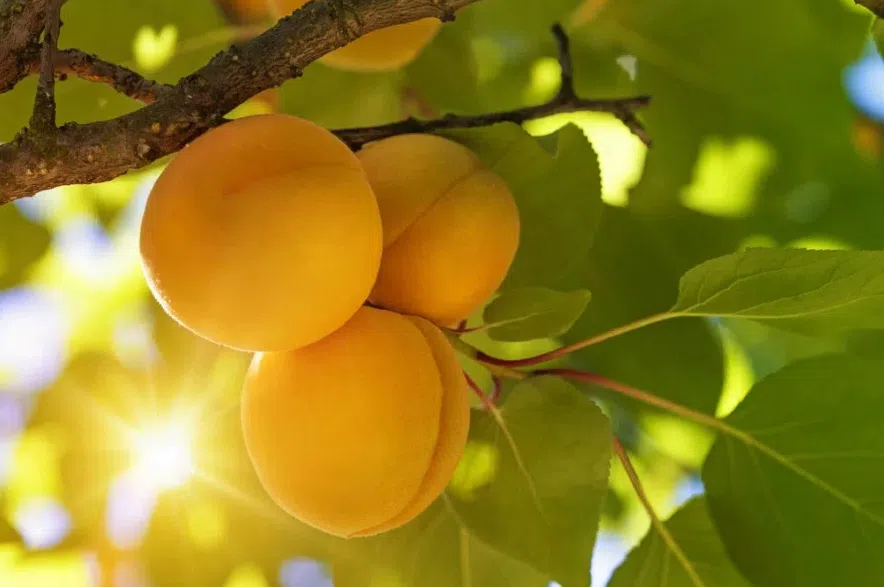Jill and Rick Van Duyvendyk answer all your gardening questions in Garden Talk on 650 CKOM and 980 CJME every Sunday morning at 9 a.m.
Here are some questions and answers from the March 30 show:
Read more:
- Garden Talk: Tips for planning a thriving home vegetable garden
- Garden Talk: What should I do now to get my Sask. garden ready for spring?
- Garden Talk: Leave your leaves to help the ladybug population
These questions and answers have been edited and condensed for clarity.
Q: Can I grow apricots in Saskatchewan?
A: They need a sheltered area but otherwise they do grow here. Apricots tend to bloom a little bit earlier so if you get a really late frost, it knocks the blooms off.
It is best to have two varieties if you can. Westcot is one you’ll see around a lot and Morden 604. If you have two of them, you’ll get a better crop.
Keep them pruned, removing any broken branches and crossing branches to keep diseases out of the tree and use an organic fertilizer with not too much nitrogen.
Apricots grown here will not be as big as you see in the store but they taste like an apricot. Wrap the base in winter to keep the voles and rabbits away because they like the taste of the bark. Also, if there’s lots of sun reflecting off the snow, put a tree guard on to stop sun scald.
Q: What do I need to do to get my water plants thriving again after being in a garbage bag in cold storage for winter?
A: You can start getting them going now, but they’re going to be a little bit stinky from sitting in that garbage bag. Take a low dish filled with water and bottom soak them and clean up any algae.
Cut them right back so that they start coming up from the base again, and get fertilizer spikes meant for your water plants. Stick those in one on each side of the plant and give them some daylight and they’ll start growing as long as the water temperature is warm enough.
Do it in your garage or something like that but they probably won’t do a whole lot until the outside temperature warms up unless you can give them some light and maybe a heat lamp.
See Dutch Growers guide to water plants here.
Q: How do I prune old growth caragana and what fertilizer do I use?
A: Fire the chainsaw up and go to town. You can either cut them down right down to the ground or you can trim — if they’re 12 feet high you can trim to six or whatever you want.
If they are cut right to the ground it’s gonna take a couple of years to come back because you’re going to first have little little spindles coming up. If you fertilize, that’ll actually bring the growth back quicker.
Q: How can I prevent snow mold on my lawn right now?
A: Once any ice starts melting, it’s going to be very moist underneath whch provides great conditions for snow mold. As soon as the grass gets exposed, take a leaf rake and keep fluffing up your grass.
You’re not raking it so hard, you’re digging up the soil, it’s just a light fluffing to get the air into the grass. If snow mold does some damage, do some top dressing and reseeding in those areas.
You can use a snowblower on the lawn and spread the snow evenly onto any areas of the grass that are exposed already and that will melt really quickly.
Q: Why are my ranunculus showing no signs of life yet?
A: It might take a little bit longer for them to start growing or the soil temperature might be might be too cool. You can always carefully pull one up and see if it’s starting to get little hair roots. Once they do start growing they don’t like to be too warm.
Q: How and when should I transplant pine trees when they are a foot or two tall?
A: At that size, they can almost be transplanted bare root but it’s best if you can take them with a little bit of soil. The roots aren’t going to be deep but they will be wide.
You can dig them up with a back hoe if you want then transplant them in the same type of soil as soon as the frost is out of the ground.
Water them over the summer and for the first two years so that they get established again. If you want to fertilize them, that will help just help them to establish even better. Put them at least 10 to 12 feet apart.
Q: What vegetable seeds should I be starting now?
A: It’s too late for some peppers but bell peppers can be started now, as well as tomato plants.
Get onions going as well as herbs, especially woody herbs like tarragon and rosemary.
Start cucumbers around April 15, then that gives them a month before you plant them out.
You can start squash now but they don’t like their roots to be disturbed
later on so put them in a peat pot you can just transfer into the soil.
Q: Why are my African violet leaves soft and droopy? They’re not overwatered and there are no bugs.
A: Check the root system — that will tell you a lot. If they have a healthy root system, they’ll be white. Brush them with your finger and they’ll come apart in one piece. If you’re brushing them with your finger and they’re flaking apart, it means there is too much moisture. Sometimes we don’t think that we’re overwatering them, but we are.
They’re also sensitive to cool temperatures so if they are too close to a window, that might be a reason. African violets like well-drained soil so the soil might be too compact or maybe it’s a garden soil instead of a soil mix.
Always bottom water African violets, don’t water them from the top — they don’t like water on the leaves.
Read more:
- Garden Talk: Tips for planning a thriving home vegetable garden
- Garden Talk: What should I do now to get my Sask. garden ready for spring?
- Garden Talk: Leave your leaves to help the ladybug population











